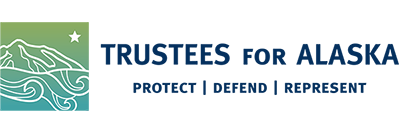
Top Ten Reasons Trustees for Alaska Defends Bristol Bay from the Pebble Project
 Bristol Bay is pristine and wild.
Bristol Bay is pristine and wild.
Spanning an area almost as large as the nation’s 10 smallest states combined, the region provides habitat for 29 species of fish, 109 species of birds, and 40 species of land mammals. The Bristol Bay region is unspoiled and scenic and crosses two national parks, five national wildlife refuges, and hosts the largest state park in the nation.
The Pebble Mine would be huge.
The Pebble open pit mine could be 7 square miles in area and a mile deep, deeper than nearby Lake Iliamna, the largest lake in Alaska. The entire mine complex would cover an area larger than Manhattan Island. It would require a hundred-mile road to be built across wetlands, watersheds, and mountains in order to connect the mine to Cook Inlet for shipping out the concentrated ore and bringing in supplies to the remote mine.
Hardrock mining produces acidic and heavy metal-laden waters harmful to fish, wildlife, and people. Roman era mines in Great Britain continue to generate acid drainage 2,000 years later.
 Huge amounts of toxic waste would be generated.
Huge amounts of toxic waste would be generated.
Just one of the earthen tailings dams to contain waste water, crushed ore, and chemical residue from the Pebble open pit mine would rise 700 feet, taller than the Washington Monument, be thicker than the length of two football fields in width, and exceed 2 miles in length. This isn’t a concrete dam harnessing energy from a river. Altogether, the dams for Pebble would need to hold back approximately 11 billion tons of mine tailings waste.
See how the dam compares to Washington DC and/or Boston.
The same company Pebble hired to design its earthen dams, Knight Piésold, designed the Mt. Polley tailings dam that breached in early August. The breach spilled millions of tons of toxic mining waste into the nearby stream and lake systems that drain into the Fraser River, with an already struggling salmon run. The Bristol Bay region is highly seismic. We cannot risk a toxic waste breach in a significant earthquake.
Watch Videos of Mt. Polley Destruction
 The world’s largest sockeye salmon run.
The world’s largest sockeye salmon run.
Bristol Bay watersheds produce more salmon than any spot on the planet. Thirty to forty million sockeye salmon return annually to spawn in the watersheds of Bristol Bay. Half of Bristol Bay’s salmon originate from only two river systems, the Kvichak and Nushagak. The Pebble Mine would sit between the headwaters of these two rivers. Bristol Bay rivers and streams are also home to some of the world’s largest rainbow trout.
 Salmon enrich everything around them.
Salmon enrich everything around them.
From embryos to spawning, salmon are a rich source of nutrients, feeding entire ecosystems from the largest carnivores to tiny protozoa. Those nutrients are spread across the landscape and, like fish fertilizer used in your home garden, builds lush vegetation even in Alaska’s northern climate.
 Fish are a renewable economic driver.
Fish are a renewable economic driver.
14,000 jobs and $1.5 billion annually are generated by a renewable source—wild salmon and rainbow trout sportfishing. Additional jobs span the country from seafood restaurants to boat building enterprises.
 The people of Southwest Alaska.
The people of Southwest Alaska.
For millenia, Alaska Native peoples have thrived in Bristol Bay with salmon harvest as an essential year-round food source. We cannot trade 10,000 years for 50 years of mining. Watch this video to learn more.
Pebble Mine would have unacceptable adverse effects on Bristol Bay. Even if nothing went wrong, it would destroy 100 miles of salmon streams, alter flows of 33 miles of salmon streams, and eradicate over 5,000 acres of wetlands, ponds and lakes. The threat of toxic contamination would remain long after active mining ceased. Longer than our lifespans. Longer than our grandchildrens’. Longer than their grandchildrens’ grandchildren…
Read about Trustees for Alaska’s work to protect Bristol Bay
Support Trustees for Alaska: Donate Now






